RabbitMQ 消息中间件
MQ全称为Message Queue,消息队列是应用程序和应用程序之间的通信方法。
- 系统可用性降低:系统引入的外部依赖越多,系统稳定性越差。一旦 MQ 宕机,就会对业务造成影响。如何保证MQ的高可用
- 系统复杂度提高:MQ 的加入大大增加了系统的复杂度,以前系统间是同步的远程调用,现在是通过 MQ 进行异步调用。如何保证消息没有被重复消费?怎么处理消息丢失情况?那么保证消息传递的顺序性?
- 一致性问题:A 系统处理完业务,通过 MQ 给B、C、D三个系统发消息数据,如果 B 系统、C 系统处理成功,D 系统处理失败。如何保证消息数据处理的一致性?
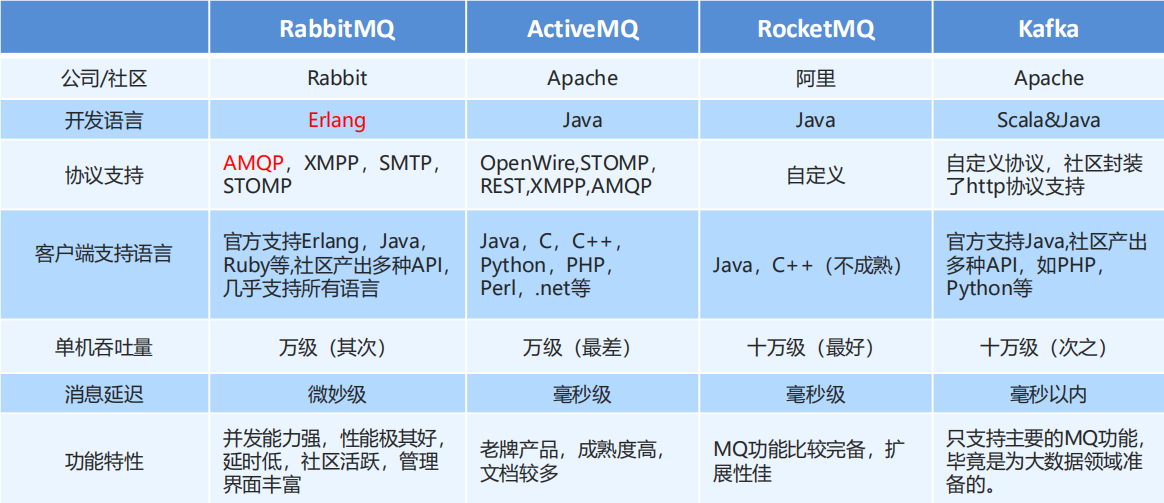
- RabbitMQ 是基于 AMQP 协议使用 Erlang 语言开发的一款消息队列产品。
- AMQP 是协议,类比HTTP AMQP,即 Advanced Message Queuing Protocol(高级消息队列协议),是一个网络协议,是应用层协议的一个开放标准,为面向消息的中间件设计。基于此协议的客户端与消息中间件可传递消息,并不受客户端/中间件不同产品,不同的开发语言等条件的限制
- RabbitMQ提供了6种工作模式
- JMS 是 API 规范接口,类比 JDBC。JMS 即 Java 消息服务(JavaMessage Service)应用程序接口,是一个 Java 平台中关于面向消息中间件
的API

Rabbit 的五种工作模式
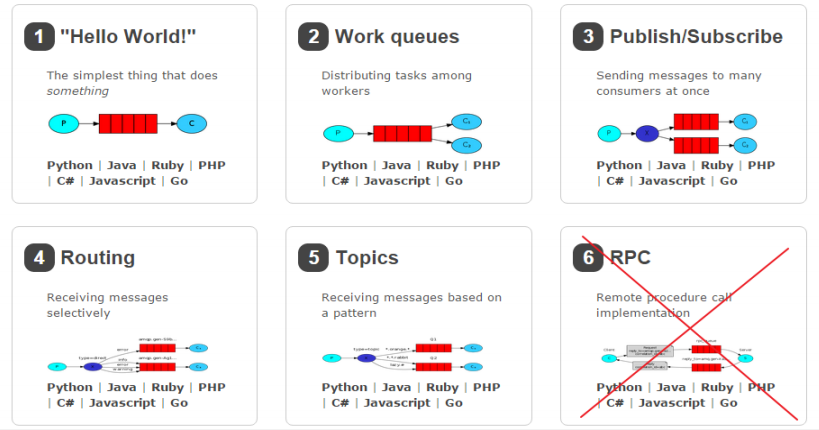
第一种工作模式代码
提供端
1 public class Producer { 2 public static void main(String[] args) throws IOException, TimeoutException { 3 //1、创建连接工长 4 ConnectionFactory factory = new ConnectionFactory(); 5 //2、设置参数 6 factory.setHost("127.0.0.1");//设置ip,默认为localhost 7 factory.setPort(5672);//设置端口号,默认5672 8 factory.setVirtualHost("/zhb");//设置默认虚拟机 9 factory.setUsername("zhb");//设置用户名 默认 guest 10 factory.setPassword("zhb");//设置密码 11 //3、获取连接 12 Connection connection = factory.newConnection(); 13 //4、创建Channel 14 Channel channel = connection.createChannel(); 15 //5、创建对列queue 16 /* 17 queueDeclare(String queue, boolean durable, boolean exclusive, boolean autoDelete, Map<String, Object> arguments) 18 1.queue 设置队列名称 19 2.durable 是否进行持久化,当mq重启后,这个队列还存在 20 3.exclusive 是否独占,只能有一个消费者监听这个队列 21 4.autoDelete 是否自动删除,当没有消费者,自动删除 22 5.arguments 参数, 23 */ 24 //如果有这个名字的交换机,就不创建,没有就创建 25 channel.queueDeclare("hello_word",true,false,false,null); 26 //6、发送消息 27 /* 28 basicPublish(String exchange, String routingKey, BasicProperties props, byte[] body) 29 1.exchange 交换机名称 ,简单模式下使用默认交换机,"" 30 2.routingKey 路由名称 简单模式下,与队列名称一致就可 31 3.props: 配置信息 32 4.body发送的消息数据 33 */ 34 byte[] body = "hello_word mq".getBytes(); 35 channel.basicPublish("","hello_word",null,body); 36 37 //7、关闭资源 38 channel.close(); 39 connection.close(); 40 41 } 42 }
消费端
1 public class consumer { 2 public static void main(String[] args) throws IOException, TimeoutException { 3 //1、创建连接工长 4 ConnectionFactory factory = new ConnectionFactory(); 5 //2、设置参数 6 factory.setHost("127.0.0.1");//设置ip,默认为localhost 7 factory.setPort(5672);//设置端口号,默认5672 8 factory.setVirtualHost("/zhb");//设置默认虚拟机 9 factory.setUsername("zhb");//设置用户名 默认 guest 10 factory.setPassword("zhb");//设置密码 11 //3、获取连接 12 Connection connection = factory.newConnection(); 13 //4、创建Channel 14 Channel channel = connection.createChannel(); 15 //5、接收消息 16 /* 17 basicConsume(String queue, boolean autoAck, Consumer callback) 18 1.queue 队列名称 19 2.autoAck 是否自动确认 20 3.callback: 回调对象 21 */ 22 Consumer consumer = new DefaultConsumer(channel){ 23 /** 24 * 回调方法,当收到消息后,会自动执行该方法 25 * @param consumerTag 标识 26 * @param envelope 获取一些信息,交换机,路由key 27 * @param properties 配置信息 28 * @param body 收到的消息 29 * @throws IOException 异常 30 */ 31 public void handleDelivery(String consumerTag, Envelope envelope, AMQP.BasicProperties properties, byte[] body) throws IOException { 32 System.out.println("consumerTag = " + consumerTag); 33 System.out.println("Exchange = " + envelope.getExchange()); 34 System.out.println("RoutingKey = " + envelope.getRoutingKey()); 35 System.out.println("properties = " + properties); 36 System.out.println("body = " + new String(body)); 37 } 38 }; 39 channel.basicConsume("hello_word",true,consumer); 40 } 41 }
第二种工作模式 Work queue

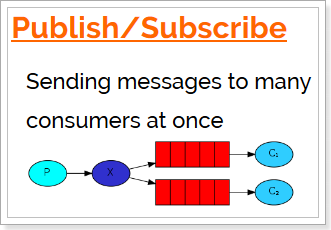
1 public class Producer_Fanout { 2 public static void main(String[] args) throws IOException, TimeoutException { 3 //1、创建连接工长 4 ConnectionFactory factory = new ConnectionFactory(); 5 //2、设置参数 6 factory.setHost("127.0.0.1");//设置ip,默认为localhost 7 factory.setPort(5672);//设置端口号,默认5672 8 factory.setVirtualHost("/zhb");//设置默认虚拟机 9 factory.setUsername("zhb");//设置用户名 默认 guest 10 factory.setPassword("zhb");//设置密码 11 //3、获取连接 12 Connection connection = factory.newConnection(); 13 //4、创建Channel 14 Channel channel = connection.createChannel(); 15 16 /* 17 exchangeDeclare(String exchange, BuiltinExchangeType type, 18 boolean durable, boolean autoDelete, boolean internal, 19 Map<String, Object> arguments) 20 1.exchange 交换机名称 21 2.type 交换机类型 22 DIRECT("direct")定向 23 FANOUT("fanout")扇形(广播)发送消息到每一个队列 24 TOPIC("topic")通配符方式 25 HEADERS("headers")参数匹配 26 3.durable 是否持久化 27 4.autoDelete 是否自动删除 28 5.internal 内部使用一般为false 29 6.arguments 参数 30 31 */ 32 //5、创建交换机 33 channel.exchangeDeclare("test_fanout", BuiltinExchangeType.FANOUT,true,false,false,null); 34 //6、创建对列queue 35 /* 36 queueDeclare(String queue, boolean durable, boolean exclusive, boolean autoDelete, Map<String, Object> arguments) 37 1.queue 设置队列名称 38 2.durable 是否进行持久化,当mq重启后,这个队列还存在 39 3.exclusive 是否独占,只能有一个消费者监听这个队列 40 4.autoDelete 是否自动删除,当没有消费者,自动删除 41 5.arguments 参数, 42 */ 43 //如果有这个名字的交换机,就不创建,没有就创建 44 channel.queueDeclare("fanout_queues1",true,false,false,null); 45 channel.queueDeclare("fanout_queues2",true,false,false,null); 46 //7、队列于交换机绑定 47 channel.queueBind("fanout_queues1","test_fanout",""); 48 channel.queueBind("fanout_queues2","test_fanout",""); 49 50 //8、发送消息 51 /* 52 basicPublish(String exchange, String routingKey, BasicProperties props, byte[] body) 53 1.exchange 交换机名称 ,简单模式下使用默认交换机,"" 54 2.routingKey 路由名称 广播模式下使用"" 55 3.props: 配置信息 56 4.body发送的消息数据 57 */ 58 for (int i = 0; i < 10; i++) { 59 byte[] body = ("hello_world mq :"+i).getBytes(); 60 61 channel.basicPublish("test_fanout","",null,body); 62 } 63 64 //7、关闭资源 65 channel.close(); 66 connection.close(); 67 68 } 69 }
1 public class Consumer_Fanout { 2 public static void main(String[] args) throws IOException, TimeoutException { 3 //1、创建连接工长 4 ConnectionFactory factory = new ConnectionFactory(); 5 //2、设置参数 6 factory.setHost("127.0.0.1");//设置ip,默认为localhost 7 factory.setPort(5672);//设置端口号,默认5672 8 factory.setVirtualHost("/zhb");//设置默认虚拟机 9 factory.setUsername("zhb");//设置用户名 默认 guest 10 factory.setPassword("zhb");//设置密码 11 //3、获取连接 12 Connection connection = factory.newConnection(); 13 //4、创建Channel 14 Channel channel = connection.createChannel(); 15 //5、接收消息 16 /* 17 basicConsume(String queue, boolean autoAck, Consumer callback) 18 1.queue 队列名称 19 2.autoAck 是否自动确认 20 3.callback: 回调对象 21 */ 22 Consumer consumer = new DefaultConsumer(channel){ 23 /** 24 * 回调方法,当收到消息后,会自动执行该方法 25 * @param consumerTag 标识 26 * @param envelope 获取一些信息,交换机,路由key 27 * @param properties 配置信息 28 * @param body 收到的消息 29 * @throws IOException 异常 30 */ 31 public void handleDelivery(String consumerTag, Envelope envelope, AMQP.BasicProperties properties, byte[] body) throws IOException { 32 /*System.out.println("consumerTag = " + consumerTag);*/ 33 System.out.println("Exchange = " + envelope.getExchange()); 34 System.out.println("RoutingKey = " + envelope.getRoutingKey()); 35 /*System.out.println("properties = " + properties); 36 System.out.println("body = " + new String(body));*/ 37 } 38 }; 39 // channel.basicConsume("fanout_queues1",true,consumer); 40 channel.basicConsume("fanout_queues2",true,consumer); 41 } 42 }
第四种工作模式 Routing 路由模式
路由模式特点:
-
-
消息的发送方在 向 Exchange发送消息时,也必须指定消息的
RoutingKey。 -
Exchange不再把消息交给每一个绑定的队列,而是根据消息的
Routing Key进行判断,只有队列的Routingkey与消息的Routing key完全一致,才会接收到消息
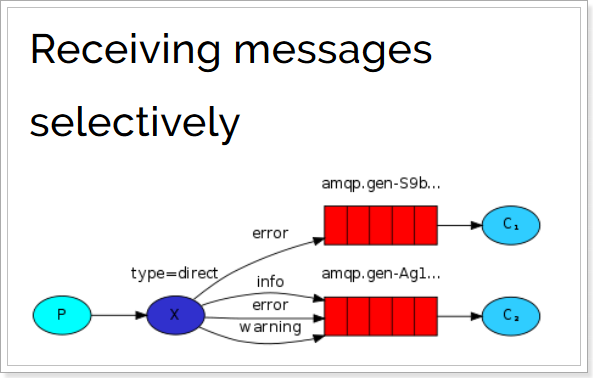
生产者代码 重新修改交换机类型(direct)并为列配上不同的路由key,向他们发送消息
1 public class Producer_Rounting { 2 public static void main(String[] args) throws IOException, TimeoutException { 3 //1、创建连接工长 4 ConnectionFactory factory = new ConnectionFactory(); 5 //2、设置参数 6 factory.setHost("127.0.0.1");//设置ip,默认为localhost 7 factory.setPort(5672);//设置端口号,默认5672 8 factory.setVirtualHost("/zhb");//设置默认虚拟机 9 factory.setUsername("zhb");//设置用户名 默认 guest 10 factory.setPassword("zhb");//设置密码 11 //3、获取连接 12 Connection connection = factory.newConnection(); 13 //4、创建Channel 14 Channel channel = connection.createChannel(); 15 16 /* 17 exchangeDeclare(String exchange, BuiltinExchangeType type, 18 boolean durable, boolean autoDelete, boolean internal, 19 Map<String, Object> arguments) 20 1.exchange 交换机名称 21 2.type 交换机类型 22 DIRECT("direct")定向 23 FANOUT("fanout")扇形(广播)发送消息到每一个队列 24 TOPIC("topic")通配符方式 25 HEADERS("headers")参数匹配 26 3.durable 是否持久化 27 4.autoDelete 是否自动删除 28 5.internal 内部使用一般为false 29 6.arguments 参数 30 31 */ 32 //5、创建交换机 33 channel.exchangeDeclare("test_direct", BuiltinExchangeType.DIRECT, true, false, false, null); 34 //6、创建对列queue 35 /* 36 queueDeclare(String queue, boolean durable, boolean exclusive, boolean autoDelete, Map<String, Object> arguments) 37 1.queue 设置队列名称 38 2.durable 是否进行持久化,当mq重启后,这个队列还存在 39 3.exclusive 是否独占,只能有一个消费者监听这个队列 40 4.autoDelete 是否自动删除,当没有消费者,自动删除 41 5.arguments 参数, 42 */ 43 //如果有这个名字的交换机,就不创建,没有就创建 44 channel.queueDeclare("direct_queues1", true, false, false, null); 45 channel.queueDeclare("direct_queues2", true, false, false, null); 46 //7、队列于交换机绑定 47 /* 48 queueBind(String queue, String exchange, String routingKey) 49 */ 50 channel.queueBind("direct_queues1", "test_direct", "insert"); 51 channel.queueBind("direct_queues1", "test_direct", "update"); 52 channel.queueBind("direct_queues2", "test_direct", "update"); 53 54 //8、发送消息 55 /* 56 basicPublish(String exchange, String routingKey, BasicProperties props, byte[] body) 57 1.exchange 交换机名称 ,简单模式下使用默认交换机,"" 58 2.routingKey 路由名称 广播模式下使用"" 59 3.props: 配置信息 60 4.body发送的消息数据 61 */ 62 63 byte[] body1 = ("hello_world mq : insert").getBytes(); 64 byte[] body2 = ("hello_world mq : update").getBytes(); 65 channel.basicPublish("test_direct", "insert", null, body1); 66 channel.basicPublish("test_direct", "update", null, body2); 67 68 69 //7、关闭资源 70 channel.close(); 71 connection.close(); 72 73 } 74 }
消费端代码 与传播类似
第五种方式 Topics通配符模式
Routingkey 一般都是有一个或多个单词组成,多个单词之间以”.”分割,例如: item.insert
通配符规则:
#
*:匹配不多不少恰好1个词
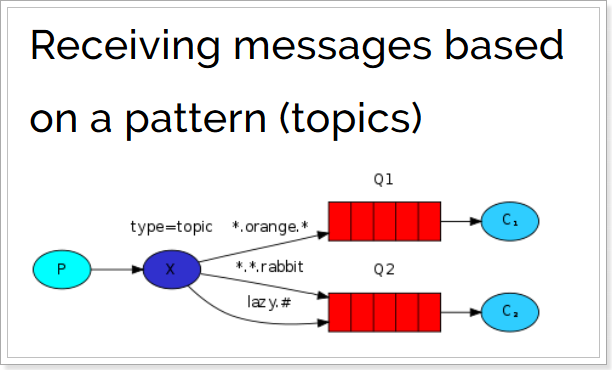
模式总计:
1、简单模式 HelloWorld
一个生产者、一个消费者,不需要设置交换机(使用默认的交换机)
2、工作队列模式 WorkQueue
一个生产者、多个消费者(竞争关系),不需要设置交换机(使用默认的交换机)
3、发布订阅模式 Publish/Subscribe
需要设置类型为fanout的交换机,并且交换机和队列进行绑定,当发送消息到交换机后,交换机会将消息发送到绑定的队列
4、路由模式 Rounting
需要设置类型为direct的交换机,交换机和队列进行绑定,并且指定routing key,当发送消息到交换机后,交换机会根据routing key将消息发送到对应的队列
5、通配符模式Topic
需要设置类型为topic的交换机,交换机和队列进行绑定,并且指定通配符方式的routing key,当发送消息到交换机后,交换机会根据routing key将消息发送到对应的队列
Spring整合RabbitMQ
生产者依赖
生产者xml
1 rabbitmq.host=192.168.12.135 2 rabbitmq.port=5672 3 rabbitmq.username=**** 4 rabbitmq.password=**** 5 rabbitmq.virtual-host=/****
1 <?xml version="1.0" encoding="UTF-8"?> 2 <beans xmlns="http://www.springframework.org/schema/beans" 3 xmlns:xsi="http://www.w3.org/2001/XMLSchema-instance" 4 xmlns:context="http://www.springframework.org/schema/context" 5 xmlns:rabbit="http://www.springframework.org/schema/rabbit" 6 xsi:schemaLocation="http://www.springframework.org/schema/beans 7 http://www.springframework.org/schema/beans/spring-beans.xsd 8 http://www.springframework.org/schema/context 9 https://www.springframework.org/schema/context/spring-context.xsd 10 http://www.springframework.org/schema/rabbit 11 http://www.springframework.org/schema/rabbit/spring-rabbit.xsd"> 12 <!--加载配置文件--> 13 <context:property-placeholder location="classpath:properties/rabbitmq.properties"/> 14 15 <!-- 定义rabbitmq connectionFactory --> 16 <rabbit:connection-factory id="connectionFactory" host="${rabbitmq.host}" 17 port="${rabbitmq.port}" 18 username="${rabbitmq.username}" 19 password="${rabbitmq.password}" 20 virtual-host="${rabbitmq.virtual-host}"/> 21 <!--定义管理交换机、队列--> 22 <rabbit:admin connection-factory="connectionFactory"/> 23 24 <!--定义持久化队列,不存在则自动创建;不绑定到交换机则绑定到默认交换机 25 默认交换机类型为direct,名字为:"",路由键为队列的名称 26 --> 27 <rabbit:queue id="spring_queue" name="spring_queue" auto-declare="true"/> 28 29 <!-- ~~~~~~~~~~~~~~~~~~~~~~~~~~~~广播;所有队列都能收到消息~~~~~~~~~~~~~~~~~~~~~~~~~~~~ --> 30 <!--定义广播交换机中的持久化队列,不存在则自动创建--> 31 <rabbit:queue id="spring_fanout_queue_1" name="spring_fanout_queue_1" auto-declare="true"/> 32 33 <!--定义广播交换机中的持久化队列,不存在则自动创建--> 34 <rabbit:queue id="spring_fanout_queue_2" name="spring_fanout_queue_2" auto-declare="true"/> 35 36 <!--定义广播类型交换机;并绑定上述两个队列--> 37 <rabbit:fanout-exchange id="spring_fanout_exchange" name="spring_fanout_exchange" auto-declare="true"> 38 <rabbit:bindings> 39 <rabbit:binding queue="spring_fanout_queue_1"/> 40 <rabbit:binding queue="spring_fanout_queue_2"/> 41 </rabbit:bindings> 42 </rabbit:fanout-exchange> 43 44 <!-- ~~~~~~~~~~~~~~~~~~~~~~~~~~~~通配符;*匹配一个单词,#匹配多个单词 ~~~~~~~~~~~~~~~~~~~~~~~~~~~~ --> 45 <!--定义广播交换机中的持久化队列,不存在则自动创建--> 46 <rabbit:queue id="spring_topic_queue_star" name="spring_topic_queue_star" auto-declare="true"/> 47 <!--定义广播交换机中的持久化队列,不存在则自动创建--> 48 <rabbit:queue id="spring_topic_queue_well" name="spring_topic_queue_well" auto-declare="true"/> 49 <!--定义广播交换机中的持久化队列,不存在则自动创建--> 50 <rabbit:queue id="spring_topic_queue_well2" name="spring_topic_queue_well2" auto-declare="true"/> 51 52 <rabbit:topic-exchange id="spring_topic_exchange" name="spring_topic_exchange" auto-declare="true"> 53 <rabbit:bindings> 54 <rabbit:binding pattern="heima.*" queue="spring_topic_queue_star"/> 55 <rabbit:binding pattern="heima.#" queue="spring_topic_queue_well"/> 56 <rabbit:binding pattern="itcast.#" queue="spring_topic_queue_well2"/> 57 </rabbit:bindings> 58 </rabbit:topic-exchange> 59 60 <!--定义rabbitTemplate对象操作可以在代码中方便发送消息--> 61 <rabbit:template id="rabbitTemplate" connection-factory="connectionFactory"/> 62 </beans>
生产者代码
1 @RunWith(SpringJUnit4ClassRunner.class) 2 @ContextConfiguration(locations = "classpath:spring/spring-rabbitmq.xml") 3 public class ProducerTest { 4 5 @Autowired 6 private RabbitTemplate rabbitTemplate; 7 8 /** 9 * 只发队列消息 10 * 默认交换机类型为 direct 11 * 交换机的名称为空,路由键为队列的名称 12 */ 13 @Test 14 public void queueTest(){ 15 //路由键与队列同名 16 rabbitTemplate.convertAndSend("spring_queue", "只发队列spring_queue的消息。"); 17 } 18 19 /** 20 * 发送广播 21 * 交换机类型为 fanout 22 * 绑定到该交换机的所有队列都能够收到消息 23 */ 24 @Test 25 public void fanoutTest(){ 26 /** 27 * 参数1:交换机名称 28 * 参数2:路由键名(广播设置为空) 29 * 参数3:发送的消息内容 30 */ 31 rabbitTemplate.convertAndSend("spring_fanout_exchange", "", "发送到spring_fanout_exchange交换机的广播消息"); 32 } 33 34 /** 35 * 通配符 36 * 交换机类型为 topic 37 * 匹配路由键的通配符,*表示一个单词,#表示多个单词 38 * 绑定到该交换机的匹配队列能够收到对应消息 39 */ 40 @Test 41 public void topicTest(){ 42 /** 43 * 参数1:交换机名称 44 * 参数2:路由键名 45 * 参数3:发送的消息内容 46 */ 47 rabbitTemplate.convertAndSend("spring_topic_exchange", "heima.bj", "发送到spring_topic_exchange交换机heima.bj的消息"); 48 rabbitTemplate.convertAndSend("spring_topic_exchange", "heima.bj.1", "发送到spring_topic_exchange交换机heima.bj.1的消息"); 49 rabbitTemplate.convertAndSend("spring_topic_exchange", "heima.bj.2", "发送到spring_topic_exchange交换机heima.bj.2的消息"); 50 rabbitTemplate.convertAndSend("spring_topic_exchange", "itcast.cn", "发送到spring_topic_exchange交换机itcast.cn的消息"); 51 } 52 }
消费者依赖
1 <?xml version="1.0" encoding="UTF-8"?> 2 <project xmlns="http://maven.apache.org/POM/4.0.0" 3 xmlns:xsi="http://www.w3.org/2001/XMLSchema-instance" 4 xsi:schemaLocation="http://maven.apache.org/POM/4.0.0 http://maven.apache.org/xsd/maven-4.0.0.xsd"> 5 <modelVersion>4.0.0</modelVersion> 6 7 <groupId>com.itheima</groupId> 8 <artifactId>spring-rabbitmq-consumer</artifactId> 9 <version>1.0-SNAPSHOT</version> 10 <dependencies> 11 <dependency> 12 <groupId>org.springframework</groupId> 13 <artifactId>spring-context</artifactId> 14 <version>5.1.7.RELEASE</version> 15 </dependency> 16 17 <dependency> 18 <groupId>org.springframework.amqp</groupId> 19 <artifactId>spring-rabbit</artifactId> 20 <version>2.1.8.RELEASE</version> 21 </dependency> 22 </dependencies> 23 24 25 </project>
消费者xml
1 rabbitmq.host=192.168.12.135 2 rabbitmq.port=5672 3 rabbitmq.username=**** 4 rabbitmq.password=**** 5 rabbitmq.virtual-host=/****
1 <?xml version="1.0" encoding="UTF-8"?> 2 <beans xmlns="http://www.springframework.org/schema/beans" 3 xmlns:xsi="http://www.w3.org/2001/XMLSchema-instance" 4 xmlns:context="http://www.springframework.org/schema/context" 5 xmlns:rabbit="http://www.springframework.org/schema/rabbit" 6 xsi:schemaLocation="http://www.springframework.org/schema/beans 7 http://www.springframework.org/schema/beans/spring-beans.xsd 8 http://www.springframework.org/schema/context 9 https://www.springframework.org/schema/context/spring-context.xsd 10 http://www.springframework.org/schema/rabbit 11 http://www.springframework.org/schema/rabbit/spring-rabbit.xsd"> 12 <!--加载配置文件--> 13 <context:property-placeholder location="classpath:properties/rabbitmq.properties"/> 14 15 <!-- 定义rabbitmq connectionFactory --> 16 <rabbit:connection-factory id="connectionFactory" host="${rabbitmq.host}" 17 port="${rabbitmq.port}" 18 username="${rabbitmq.username}" 19 password="${rabbitmq.password}" 20 virtual-host="${rabbitmq.virtual-host}"/> 21 22 <bean id="springQueueListener" class="com.itheima.rabbitmq.listener.SpringQueueListener"/> 23 <bean id="fanoutListener1" class="com.itheima.rabbitmq.listener.FanoutListener1"/> 24 <bean id="fanoutListener2" class="com.itheima.rabbitmq.listener.FanoutListener2"/> 25 <bean id="topicListenerStar" class="com.itheima.rabbitmq.listener.TopicListenerStar"/> 26 <bean id="topicListenerWell" class="com.itheima.rabbitmq.listener.TopicListenerWell"/> 27 <bean id="topicListenerWell2" class="com.itheima.rabbitmq.listener.TopicListenerWell2"/> 28 29 <rabbit:listener-container connection-factory="connectionFactory" auto-declare="true"> 30 <rabbit:listener ref="springQueueListener" queue-names="spring_queue"/> 31 <rabbit:listener ref="fanoutListener1" queue-names="spring_fanout_queue_1"/> 32 <rabbit:listener ref="fanoutListener2" queue-names="spring_fanout_queue_2"/> 33 <rabbit:listener ref="topicListenerStar" queue-names="spring_topic_queue_star"/> 34 <rabbit:listener ref="topicListenerWell" queue-names="spring_topic_queue_well"/> 35 <rabbit:listener ref="topicListenerWell2" queue-names="spring_topic_queue_well2"/> 36 </rabbit:listener-container> 37 </beans>
消费者代码
1 队列监听器 2 3 public class SpringQueueListener implements MessageListener { 4 public void onMessage(Message message) { 5 try { 6 String msg = new String(message.getBody(), "utf-8"); 7 8 System.out.printf("接收路由名称为:%s,路由键为:%s,队列名为:%s的消息:%s ", 9 message.getMessageProperties().getReceivedExchange(), 10 message.getMessageProperties().getReceivedRoutingKey(), 11 message.getMessageProperties().getConsumerQueue(), 12 msg); 13 } catch (Exception e) { 14 e.printStackTrace(); 15 } 16 } 17 } 18 19 20 广播监听器1 21 public class FanoutListener1 implements MessageListener { 22 public void onMessage(Message message) { 23 try { 24 String msg = new String(message.getBody(), "utf-8"); 25 26 System.out.printf("广播监听器1:接收路由名称为:%s,路由键为:%s,队列名为:%s的消息:%s ", 27 message.getMessageProperties().getReceivedExchange(), 28 message.getMessageProperties().getReceivedRoutingKey(), 29 message.getMessageProperties().getConsumerQueue(), 30 msg); 31 } catch (Exception e) { 32 e.printStackTrace(); 33 } 34 } 35 } 36 37 38 广播监听器2 39 public class FanoutListener2 implements MessageListener { 40 public void onMessage(Message message) { 41 try { 42 String msg = new String(message.getBody(), "utf-8"); 43 44 System.out.printf("广播监听器2:接收路由名称为:%s,路由键为:%s,队列名为:%s的消息:%s ", 45 message.getMessageProperties().getReceivedExchange(), 46 message.getMessageProperties().getReceivedRoutingKey(), 47 message.getMessageProperties().getConsumerQueue(), 48 msg); 49 } catch (Exception e) { 50 e.printStackTrace(); 51 } 52 } 53 } 54 55 56 星号统配 57 public class TopicListenerStar implements MessageListener { 58 public void onMessage(Message message) { 59 try { 60 String msg = new String(message.getBody(), "utf-8"); 61 62 System.out.printf("通配符*监听器:接收路由名称为:%s,路由键为:%s,队列名为:%s的消息:%s ", 63 message.getMessageProperties().getReceivedExchange(), 64 message.getMessageProperties().getReceivedRoutingKey(), 65 message.getMessageProperties().getConsumerQueue(), 66 msg); 67 } catch (Exception e) { 68 e.printStackTrace(); 69 } 70 } 71 } 72 73 74 井号统配 75 public class TopicListenerWell implements MessageListener { 76 public void onMessage(Message message) { 77 try { 78 String msg = new String(message.getBody(), "utf-8"); 79 80 System.out.printf("通配符#监听器:接收路由名称为:%s,路由键为:%s,队列名为:%s的消息:%s ", 81 message.getMessageProperties().getReceivedExchange(), 82 message.getMessageProperties().getReceivedRoutingKey(), 83 message.getMessageProperties().getConsumerQueue(), 84 msg); 85 } catch (Exception e) { 86 e.printStackTrace(); 87 } 88 } 89 }